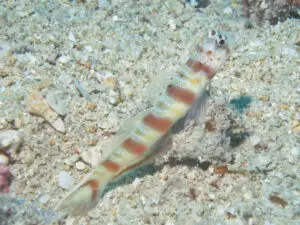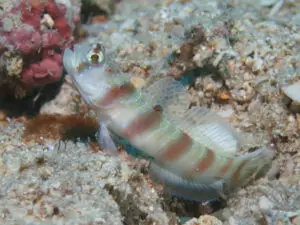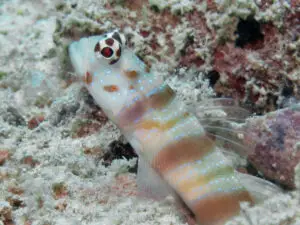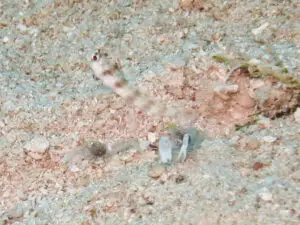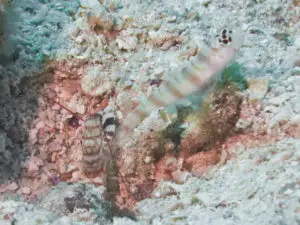Redspotted Shrimpgoby
Amblyeleotris ogasawarensis
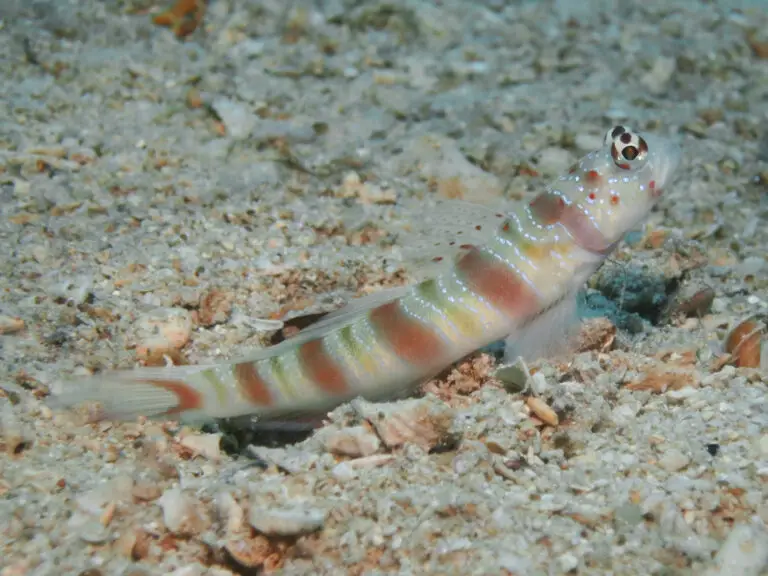
More photos needed here and replace first with sharper image
Redspotted Shrimpgoby
Amblyeleotris ogasawarensis
Yanagisawa, 1978
Description
Body design This is a beautiful medium-sized goby, growing to 10 cm, ochre with five pale brown bars along the body. The second to fourth bars are continued to the dorsal and anal fins, the extension to the first dorsal fin conspicuous, the rest faint. Between these, there are four well-defined golden bars with a fifth at the base of the tail. The first gold bar has a characteristic kink, Both the brown and the golden bars are outlined with iridescent blue dots.
The head has four yellow-outlined red spots in a curve extending from behind the eye through the gill cover to the angle of the mandible. Each of these may be centred on a variable brown patch similar to a brown line that usually runs vertically below the eye. There are scattered iridescent blue spots on the cheeks and over the top of the head. There is a red-brown patch at the angle of the jaw running a short distance along the upper and lower jaws.
Fin design The first dorsal fin is transparent with red doughnut rings outlined in red. The second dorsal fin has faint red spots. The anal fin is grey with a brown band. The caudal fin is pale yellow with a well-defined brown crescent mark and some streaking. centrally and a white upper margin.
Pelvic fin
Pectoral fin
Diagnostic features
The significant diagnostic features are the spots on the head and gill cover. and the broad yellow bands outlined by a detailed array of fine blue reflective dots. Between these are fine golden bars, the first of which has a characteristic kink. Similar species
Some other shrimp gobies of the same genus look similar but the appearance of alternating brown and yellow broad and narrow bands outlined by iridescent blue spots combined with the four red spots on the cheek is distinctive.
Amblyeleotris novaecaledoniae Goren 1981 looks similar but we have not seen this fish. Its range is described as Western Pacific: New Caledonia and Papua New Guinea. (Fishbase)
Taxonomy
Other common name: Antitropical Shrimpgoby because it supposedly occurs outside the tropics both to the north and the south. We have found it in the tropics at Lizard Island.
Natural History
Habitat
It is unusual to see this goby in shallow water. The depth range is reported to be 20 to 35 metres. We have mostly found it at 15 to 25 metres on coarse clean sand, coarse shell debris and coral rubble, sometimes on the edge of seagrass beds with patchy growth of Halophila minor and Halophila spinulosa. Usually areas of clean water and often in moderate to strong currents.
Behaviour
Like other gobies in its genus the eye surround is banded in a pattern of ochre and black. Unlike others, it does not readily turn black. Viewed from behind the pattern creates the appearance of a pair of eyes facing backwards.
A shrimpgoby at its burrow entrance puffed up and with all its fins extended displaying to another fish.
This is not an unduly timid goby and readily adapts to the presence of divers.
Distribution
Published distribution: Ogasawara Islands, Ryukyu Islands, Australia (Lizard Island to North Solitary Island), Negros in the Philippines, Indonesia.
Photographic records from New Caledonia and the atoll of Kiribati (formerly Christmas Island), Line Islands.
Our records: Australia: Lizard Island, Ribbon Reefs, Tongue Reef and south side of Low Isles, Michaelmas Cay, Flynn Reef, Whitsunday outer reefs and Tryon Island in the Capricorn Bunker group.
Associated Shrimp species
Associated Shrimps (three shrimps)
Black-sided Snapping Shrimp, Alpheus cf djeddensis
Brown Pyjama Shrimp, Alpheus ochrostriatus complex
Tiger Snapping Shrimp, Alpheus bellulus

